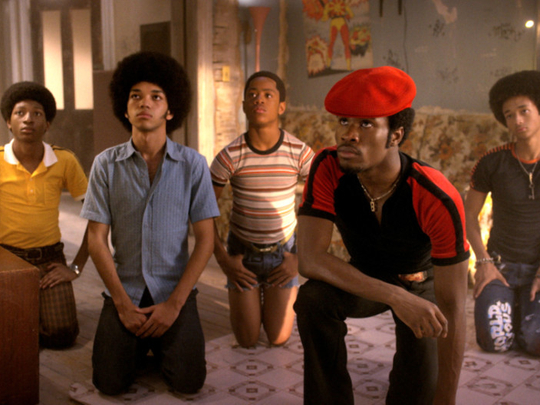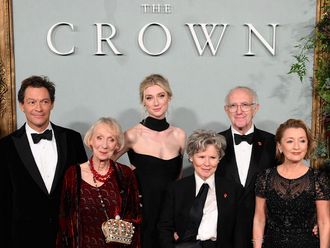
Baz Luhrmann, the movie director, has brought to Netflix his first television series, and — like his baroque takes on Romeo and Juliet and The Great Gatsby and his pop-musical rewrite of La Traviata, Moulin Rouge — it is a thing by turns, and even simultaneously, ridiculous and sublime, romantic and overwrought and the most genuinely moving precisely when it’s at its corniest
Called The Get Down, it’s a story of old school hip-hop and related arts, set in the late 1970s. It’s surely just a coincidence that The Get Down follows another ’70s-era New York City music story, Martin Scorsese’s Vinyl, already cancelled by HBO; but the proximity is instructive. Set just a few years earlier, around the birth of hip hop and punk rock, Scorsese’s series embedded itself in the business, in what was, for him, a familiar story of excess and corruption and spiritual malaise. But it forgot to love the music and the music-makers.
That is not the case here, happily. Luhrmann, who directed the feature-length opening episode himself, mucks in rapturously with the artists and the lovers — the singers, the rappers, the dancers, the spray-can painters, most of them teenagers played by teenagers. Like all else on the director’s highly aestheticised screen, down to the last carefully placed cockroach and only seemingly out-of-place hair, they have the look. But the acting is very fine all around, as well.
The Bronx is burning, literally. It’s 1977, the summer of the heat wave, the blackout and Star Wars, and like Luke Skywalker, Ezekiel Figuero (Justice Smith) is living with his aunt and his (more or less) uncle, gifted and restless. We meet him writing poems in a spiral notebook — will he be the one to take hip hop literally from “hip hop/and you don’t stop” to something Nas (an executive producer) would sign his name to? We know that he will, because we have just seen him onstage at Madison Square Garden, 20 years after the main action, rapping memory pieces that might have come off Illmatic — and were, in fact, written by Nas. (And the words “chosen one” are spoken just before Zeke takes his first turn at a microphone.)
The one thing Zeke does know is that he’s in love with his childhood friend, Mylene Cruz (Herizen Guardiola), a talented singer who just wants to “meet DJ Malibu, and give him my tape so I can get out of my father’s church and never look back ... and I can’t let anybody distract me from that.” Her pastor father, played by Giancarlo Esposito, has other ideas: “You will not sing disco, and from now on you will never leave this house.” As if that’s going to happen
Mylene gets more support from her Uncle Francisco (Jimmy Smits), a local political boss — which is not say, a politician — who looks at the burned-out blocks around Charlotte Street and envisions “houses ... not projects that were built to segregate and warehouse the working poor. ... homes for my rainbow people.” (Houses did come to Charlotte Street, history shows.) He also sees his contractors building them.
Meanwhile, fate and a tussle over a rare 12-inch remix will lead Zeke to meet and eventually partner with Shaolin Fantastic (Shameik Moore), a rarely glimpsed, legendary, red-shoed graffiti artist who parkours through the borough superheroically. “His Pumas are always pristine,” Zeke’s artistic friend Dizzee (Jaden Smith) says admiringly of Shaolin, “his hands are samurai swords, and his pieces they’re all fireworks, big, bright explosive.”
Despite his being the (unpaid) Banksy of his generation, Shaolin dreams of being a DJ like his hero-mentor Grandmaster Flash (Mamoudou Athie). Flash, who is a real-life associate producer of The Get Down, is portrayed here as a sort of gnomic Zen master working the turntables as a kind of martial art — a hero’s discipline, with mystical requirements and overtones. (Then again, most everything here has mystical overtones.) “Do not underestimate the crayon, grasshopper,” Flash says to Shaolin, having handed him a purple one. “I hand you the magic, the mystery, the opening.” But the mechanics of extending the breakbeat are also elsewhere laid out in layman’s terms.
Shaolin, however, serves two masters, one of them a gangster; and you know how that goes.
Notwithstanding that Luhrmann’s co-creator is a Pulitzer Prize-winning playwright, Stephen Adly Guirgis, there is nothing particularly fresh about the story. It is the stuff of a hundred backstage dramas, up-from-the-streets fictions and show-business biopics, going back to John Garfield and Jimmy Cagney Depression dramas, through Busby Berkeley to The Jazz Singer. But those pictures worked, and though the plot, or plots, may be formulaic, the characters have dimension: Each has his or her challenges, insights and blind spots; they have room to succeed or fail, to reward or disappoint your investment in their lives. Characters who seem to be looking for power may be really looking for redemption. There is a lot of talk of second chances — also of quests and journeys, of kings and kingdoms.
If you want a less-glamorous look at this milieu, you’ll be better off with movies like Wild Style and Beat Street, made in the Bronx back in the actual day. But what The Get Down shares with them (along with a few plot points) is the understanding that new music is also often a liberation movement: It bubbles up from the street, it gives a voice to the formerly voiceless, a way in to those to whom other ways might be blocked. It’s why the music business is often seen in such stories — as it is seen here — as the enemy of art.
“Your discos are full of drugs and homosexuality,” Pastor Cruz, missing the point, tells Kevin Corrigan’s washed-up record producer, Jackie Moreno. “There’s no place for the word of God in your disco.”
“People in the discos, they want to feel raised up,” replies Moreno, who is coked-up, junked-up and in debt to gamblers but not irredeemable. (Second chances!) “They want God, they want the light.”
Luhrmann, too, is about that sacred light, and he knows just where to shine it.
___
Don’t miss it!
The Get Down is now streaming on Netflix













